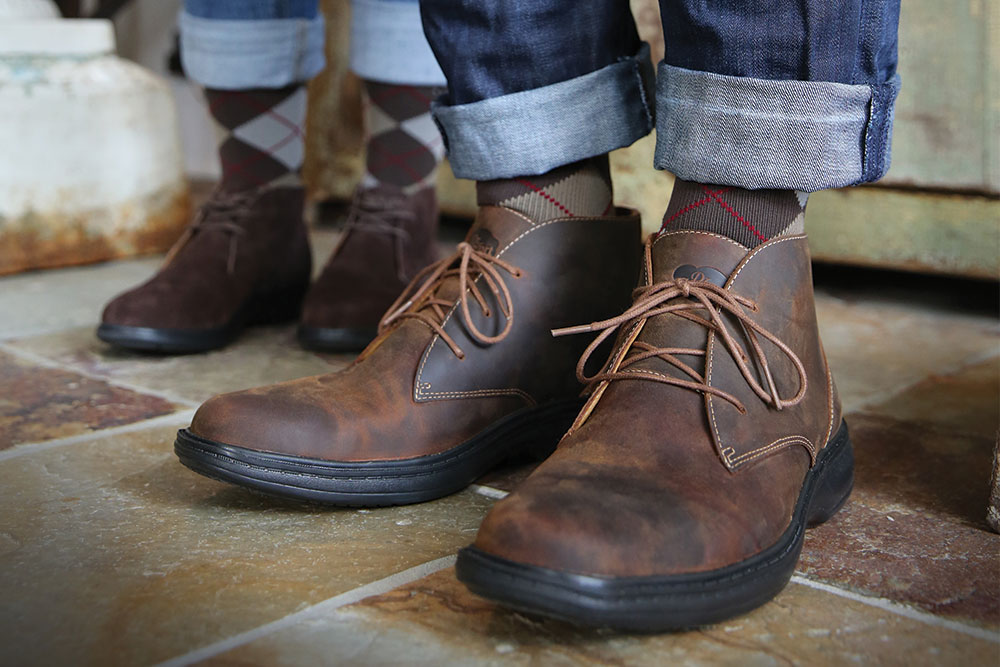How to Prepare Your Boots for the Winter
By: Mallory Lor

How to Winterize Boots: 4 Tips to Protect Your Feet This Winter
Malls are playing holiday music, the air smells like peppermint, and snowflakes are starting to fall—it’s that time of year! We’re transitioning from our fall favorites into our winter wear. Winter weather is magical, but it’s also tough on footwear, especially winter boots. Learning how to winterize boots can help protect both your shoes and your feet during the cold weather months.
Whether you rely on our orthopedic boots for women, men's orthopedic boots, a pair of sturdy leather shoes, or insulated snow boots, winter conditions like moisture, dirt, and cold weather can cause damage if proper care isn’t taken. That’s why we’ve created this how-to guide to winterize shoes and keep them in excellent condition throughout the winter months.
1. Clean Your Winter Boots Regularly
In the winter, your shoes are constantly exposed to harsh elements: dirt, salt, snow, and slush. These can cause lasting damage, especially to leather shoes and suede shoes. Salt stains in particular leave an unsightly white residue that can crack the material if left untreated.
Here’s how to remove common stains from your boots at home:
- For salt stains: Mix equal parts water and vinegar. Dab the mixture onto the stain with a clean cloth.
- For scuffs: Use a damp cloth dipped in baking soda. Gently rub the scuff until it disappears.
- For stubborn dirt: A soft brush and a leather cleaner can help lift grime from textured areas like a leather sole.
Tip: Always test any cleaning product on a small, hidden area first to ensure it doesn’t damage the material.
2. Condition Leather Shoes for Winter Weather
Leather boots need extra care during cold and wet weather. Conditioning them helps restore moisture to prevent cracking and maintains their flexibility.
Here’s how to condition your boots:
- Remove the laces to avoid staining them.
- Allow your boots to air dry completely before starting.
- Apply a small amount of leather conditioner to a soft cloth or sponge.
- Rub the conditioner evenly across the surface of the boots, paying attention to creases and seams.
- Let the boots rest overnight to fully absorb the conditioner.
- Wipe off any excess product with a clean towel.
Note: Suede shoes require a specialized conditioner designed for their delicate texture.
3. Waterproof Your Winter Boots
One of the most important steps in learning how to winterize boots is making them waterproof. Wet weather and snow can soak through unprotected materials, leaving your feet cold and your boots damaged.
Popular waterproofing options include:
- Wax-based polishes for leather boots.
- Spray-on waterproofing products for suede or fabric snow boots.
- Specialty waterproof compounds are designed for a variety of materials.
How to Waterproof Your Boots:
- Clean your boots thoroughly before applying any product.
- Test the waterproofing solution on a small, inconspicuous area first.
- Apply the product evenly, following the manufacturer’s instructions.
- Let your boots air dry. Never place them near direct heat, as this can damage the material.
Pro Tip: Repeat the waterproofing process every few weeks during the winter months to maintain the protective barrier.
4. Protect Against Winter Conditions
Prevention is key to keeping your boots looking their best. Here are some extra steps to protect your footwear during the winter months:
- Use boot trays to keep dirt and moisture off your floors.
- Invest in shoe trees to maintain the shape of your leather shoes.
- Alternate between multiple pairs of boots to give each one time to fully dry out.
For leather soles or delicate suede shoes, consider adding protective outsoles or slip-resistant covers for extra durability during icy conditions.
Why Winterize Shoes?
Taking the time to winterize your boots not only keeps them looking great but also ensures your feet stay warm, dry, and comfortable during cold and wet weather. Whether you’re wearing casual leather shoes, fashionable suede boots, or rugged snow boots, these steps will extend their lifespan and save you money in the long run.
By following this guide on how to winterize boots, you’ll be ready for anything the season throws at you!
The contents of this blog were independently prepared, and are for informational purposes only. The opinions expressed herein are those of the author and are not necessarily indicative of the views of any other party. Individual results may vary depending on a variety of patient-specific attributes and related factors.
